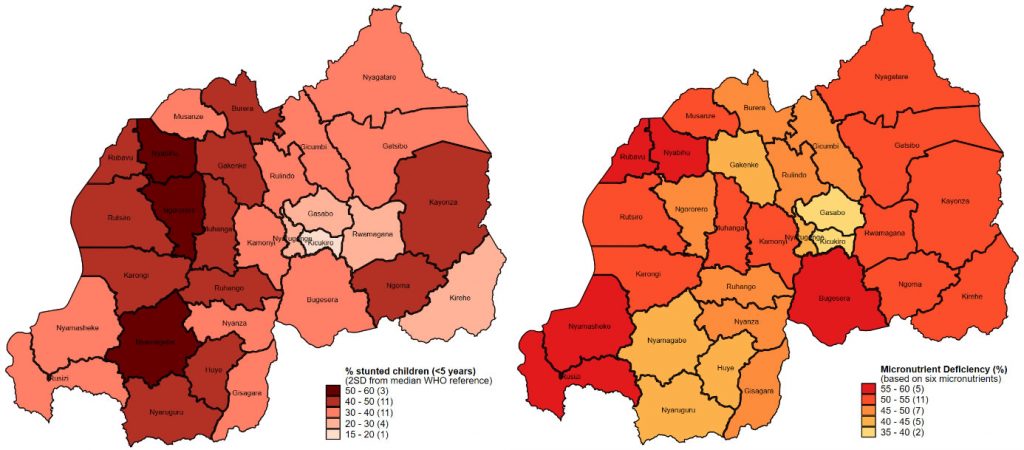 By: Wim Marivoet, Leysa Maty Sall, John M. Ulimwengu
By: Wim Marivoet, Leysa Maty Sall, John M. Ulimwengu
Rwanda recognizes nutrition as a challenge that persists even as the country advances along a trajectory of rapid economic growth.
As of 2018, an estimated 35% of children 6–59 months old are stunted, and 24% of households have inadequate food consumption levels, according to the most recent Comprehensive Food Security and Vulnerability Analysis. Many Rwandan children also face severe micronutrient deficiencies—what is often referred to as “hidden hunger.” These nutrition issues often lead to mental and physical impairment, poor health, and low productivity that endure for long periods of time.
The Government of Rwanda is strongly committed to overcoming these nutrition issues in its current policy agenda. A significant challenge to addressing these issues is understanding the very complex nature of nutrition insecurity. For example, not every district in Rwanda is affected the same way. As illustrated in Figure 1, stunting rates in 2014/15 vary between roughly 15% and 60%, while micronutrient deficiencies fall between 35% and 60% in 2013/14. At the same time, child stunting and micronutrient deficiency are not necessarily concentrated in the same districts, making their causes and drivers difficult to identify and resolve.

To significantly reduce child stunting and micronutrient deficiency, the design and implementation of food and nutrition security (FNS) policies require a sufficiently comprehensive and granular lens. This means that sectoral strategies should be thematically integrated and cognizant of location-specific conditions. In other words, development programs to increase agricultural productivity, improve market integration, or promote other related intervention need to be conceived and prioritized in terms of their nutritional impact while genuinely accounting for geographic differences across the country.
The Rwanda Policy Atlas developed under the Voice for Change Partnership (V4CP) program has precisely adopted this approach. The Voice for Change Partnership (V4CP) is a multisectoral program funded by the Dutch Ministry of Foreign Affairs (DGIS) and operated jointly by the Netherlands Development Organization (SNV) and the International Food Policy Research Institute (IFPRI).
The Atlas uses data and statistics on agriculture, food consumption, and nutrition to map various obstacles in the country’s agri-food system and help shape location-sensitive policies. The method applied to the Atlas entails the comparison and assessment of district performance along a sequence of FNS indicators to generate a set of spatial typologies. The two key typologies used in the Policy Atlas are described in greater detail in Marivoet et al. (2019) and Marivoet & Ulimwengu (2018). The Atlas relies on the rich data found in Rwanda’s 2013/14 Integrated Household Living Conditions Survey (EICV4) and the 2014/15 Demographic Health Survey (DHS). Although these data provide a snapshot that is already 5-6 years old, they represent the most comprehensive data available on FNS indicators, and offer critical insights into spatial patterns in Rwanda’s agri-food system.
To illustrate the usefulness of the Atlas, consider the FNS typology that captures relative inefficiencies in the agri-food system—inefficiencies in terms of food production, food access, and food utilization. These indicators are core pillars of food security and, when mapped to the districts of Rwanda, illustrate the considerable diversity across the country (Figure 2).

Figure 2. Low efficiency combinations, Rwanda (2014-2017). Source: Marivoet, Ulimwengu, and Sall (2020), Rwanda Policy Atlas.
For example, our findings suggest that a total of 17 districts suffer from low production efficiency, or districts with a poor performance in translating agricultural potential into food production. Examples include Huye, Nyamagabe, Gakenke, Karongi, Nyaruguru and Ngororero districts, all of which are among those districts with the highest stunting levels. Findings further suggest that much of Rwanda suffers from inadequate production of food items containing vitamin B12, a micronutrient which is only found in meat, fish, eggs, and dairy products. Findings similarly suggest inadequacies—especially in Rusizi, Huye, and Rubavu districts—in the production of dry beans, sweet potato, amaranth, Irish potato, and cassava flour, all of which contain calcium, iron and zinc. Along the same lines, findings show deficiencies in the production of various horticultural crops that contain vitamin A.
The Policy Atlas also explores possible locations of breadbaskets based on crop suitability criteria and observed production shortages to meet the country’s nutritional requirements. Findings indicate that there is opportunity for Rwanda to substantially increase the production of cereals and legumes (especially maize and soya) relative to roots and tubers, with a specific geographic focus on the eastern part of Rwanda.
The results also suggest that 15 districts in Rwanda suffer from low access efficiencies, or districts with a poor performance in translating food production into food acquisition. Ten of these districts— Nyamagabe, Gakenke, Karongi, Nyaruguru, Ngoma, Rutsiro, Nyabihu, Burera, Ruhango and Kayonza—also have critically high stunting levels. Investments that target these breadbaskets with improvements in transportation, storage, and processing infrastructure could significantly integrate Rwanda’s food markets by reducing transport times and increasing the shelf life of foods, especially perishable foods such as horticulture products. These investments could, in turn, ensure a stable supply of food to other districts in the country where production shortages are more common.
Low utilization efficiencies—poor performance in translating food acquisition into nutritional outcomes—are observed in only two districts, Kayonza and Ngororero, where stunting is particularly high. In these districts, access to a diverse range of food items is less important than how the foods are utilized in the household to determine individual health status. This includes not only culinary practices and intra-household allocation of food, but also access and utilization of healthcare, water, sanitation, and hygiene infrastructure.
This analysis demonstrates the value of designing development interventions with an integration of data on nutrition, agriculture, and geography, among many other variables. Indeed, large numbers of malnourished people may live in districts that are actually productive agricultural areas, while opportunities to address malnutrition may benefit from greater integration between districts where nutritious foods are produced and districts where it should be consumed. In other districts, food and nutrition security may only be addressed by social protection programs that bridge the gap between short-run insecurities and long-run investment in agricultural production, market integration, and infrastructure development. In still other districts, food and cash transfer programs may be particularly effective if accompanied by nutritional awareness campaigns that focus on the composition and preparation of healthy meals.
In sum, nutrition-sensitivity and spatial analysis can enrich policies and programs for agriculture and food security. In Rwanda, this speaks directly to the continued implementation of the Strategic Plan for Agricultural Transformation (PSTA). The PSTA4 defines a national food basket to estimate calorie sufficiency levels following targeted yield improvements, and could be extended by considering various macro- and micronutrients, assessing cost-efficiency of current versus alternative diets in different price zones, and estimating food self-sufficiency at district level while identifying opportunities for increased market integration. In a similar vein, the Crop Intensification Program (CIP) and similar programs for sustainable agricultural intensification could be refined to consider the interaction between Rwanda’s breadbasket districts and the location of nutrient deficiencies that these programs might address. With new rounds of EICV and DHS expected shortly, there is an opening to validate, revise, and expand on this analysis to inform policy and investment choices in the immediate future, especially during the period of economic recovery from the global COVID-19 pandemic.
References
Marivoet, W., & Ulimwengu, J.M. 2018. Mapping Nutrient Adequacy for Targeted Policy Interventions, with Application to Uganda (2013/14). IFPRI Discussion Paper no. 01764. Washington, DC: International Food Policy Research Institute. http://ebrary.ifpri.org/cdm/ref/collection/p15738coll2/id/132901
Marivoet, W., Ulimwengu, J.M., & Sedano, F. 2019. Spatial typology for targeted food and nutrition security interventions. World Development 120: 62–75. https://doi.org/10.1016/j.worlddev.2019.04.003
National Institute of Statistics of Rwanda (NISR), Ministry of Health (MOH), & ICF International. 2015. Rwanda Demographic and Health Survey 2014-15. Rockville, Maryland, USA: NISR, MOH, and ICF International.
National Institute of Statistics of Rwanda (NISR). 2016. Rwanda—Integrated Household Living Conditions Survey (EICV4), 2013-2014, Cross-Sectional Sample. Kigali: NISR. http://microdata.statistics.gov.rw/index.php
National Institute of Statistics of Rwanda (NISR), Ministry of Agriculture and Animal Resources (MINAGRI), & World Food Programme (WFP). 2018. Comprehensive Food Security and Vulnerability Analysis 2018. Kigali and Rome: NISR and WFP.
About the authors
Wim Marivoet is a Research Fellow in the Africa Regional Office of the International Food Policy Research Institute (IFPRI)
Leysa Maty Sall is an Associate Scientist in the Capacity and Deployment Department of AKADEMIYA2063
John M. Ulimwengu is a Senior Research Fellow in the Africa Regional Office of IFPRI
This blog is originally posted at rwanda.ifpri.info



